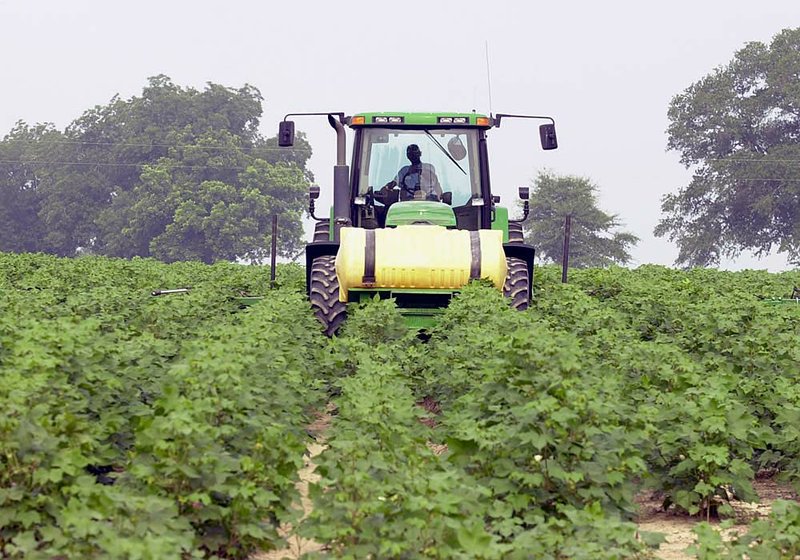LITTLE ROCK — Arkansas’ 2011 rice production is expected to be the lowest in more than a decade, down 31 percent from last year’s crop. It would be the state’s only row crop to see a decline.
Projections call for 79.5 million hundredweight of rice, according to a U.S. Department of Agriculture forecast. That’s the lowest production since 1997’s 79.2 million hundredweight. A hundredweight is 100 pounds.
A decline from last year was expected because last year saw record production numbers, said Chuck Wilson, interim director of rice research at the University of Arkansas Division of Agriculture. But the severity of the decline was due to the relatively low futures price of rice early in the year, compared with prices for corn and soybeans.
“Rice just wasn’t as attractive to a lot of growers,” Wilson said.
Wheat and corn prices as much as doubled last year, while rice prices retreated, according to Bloomberg News.
Sam Whitaker, a McGehee farmer, planted 3,500 acres of rice this year, about 20 percent less than last year. Whitaker did not plant corn in 2010, but committed 1,400 acres to it this year, because the price was higher.
“We had subpar [rice] yields last year and subpar quality so we decided to move into some different crops that might not be as risky,” he said.
Spring flooding also caused the state rice production to fall.
“There was tremendous flooding up and down the rivers,” said Carl Frein, a rice broker with Farmers’ Marketing Service in Brinkley. “Some farmers couldn’t get their crops in on time or others had their crops destroyed. Some just took their insurance and didn’t replant.” Frein estimates the flooding accounted for one-third of the overall decline in rice production.
Nationwide, rice harvests are expected to fall 22 percent, to an anticipated 188 million hundredweight.
While this summer’s severe drought and record-high temperatures made it difficult to farm across the state, the timing of the flood may have tempered the effects of the heat. The flood caused farmers to plant, or in some cases replant, their rice crops later than normal, meaning their pollination period missed some of the worst heat.
“Rice does not like weather hotter than 95 degrees because it impacts flowering, quality and yield,” Wilson said. “But it’s all about timing. A lot of rice is pollinating now, and it’s an ideal condition.”
Rice is estimated to sell for about $6.50 per bushel this year, about $1.50 more than last year.
All other state row crops are expected to produce more than last year.
Corn has a forecast of 72 million bushels, up 26 percent from last year. If realized, it will be the state’s second-largest corn crop on record, after 2007’s 100 million bushels.
“This might be the first time ever that there is more corn produced in Arkansas than rice,” said Jason Kelly, a corn agronomist at the University of Arkansas Division of Agriculture.
The high price of corn early in the year, $7 per bushel compared with $5 a bushel last year, accounts for almost all of the increase, according to Kelly.
The spring floods and summer drought made it more expensive to maintain a high yield, Kelly said, so farmers are likely to not make as much as the high commodity prices indicated.
“After it flooded, we had to replant,” Kelly said. “And then we had to water far more during the drought. It has added a lot of expense to the crop. It balances out the $2 increase per bushel we had over last year.”
The state’s yield is expected to remain the same, 150 bushels per acre.
Nationwide, drought conditions and high temperatures in the Corn Belt are expected to lower corn yields, down from an estimated 159 bushels per acre to 153 bushels. Corn acreage is up this year in response to high prices, according to The New York Times, so production is expected to be up about 4 percent, to 12.9 billion bushels. That still won’t meet demand, so meat and cooking oil prices are expected to rise across the country.
Soybeans are expected to grow 4 percent to 114 million bushels in Arkansas. Cotton is forecast to grow 11 percent, to 1.3 million 480-pound bales.
The USDA said the state’s 2011 hay crop will be the smallest since 1980 — the last drought year of any significance. For those producers able to eke out a late season cutting, the crop is expected to be profitable.
“Hay is going through the roof,” said Robert Seay, a Benton County extension agent.
“For two years in a row we’ve had depleted winter month” stocks, Seay said, and he forecasts the spring of 2012 will be no different.
Any fescue producers with one remaining field crop will likely be able to find customers in drought-stricken parts of Arkansas, Texas and Oklahoma, he said.
Based on growing conditions as of Aug. 1, the production forecast for hay, excluding alfalfa, is 2.09 million tons, a 21 percent decrease compared with 2.65 tons of hay in 2010.
Yield is forecast to average 1.4 tons per acre, down 22 percent from 1.8 tons per acre in 2010. However, the harvest is forecast to increase 14 percent to 1.49 million acres of all hay, compared with 1.47 million acres for the previous year.
The agency also released forecasts for the state’s fruit crop, which is expected to drop by double digits. A wetter than normal spring delayed growth about two weeks, spring hail damaged larger fruit like peaches, and the summer heat withered some fruit.
Peach production is expected to decline 17 percent, to 2,500 tons. Grapes are forecast to decline 33 percent, to 1,400 tons.
Information for this article was contributed by Toby Manthey and Laurie Whalen of the Arkansas Democrat-Gazette.
Business, Pages 23 on 08/16/2011
